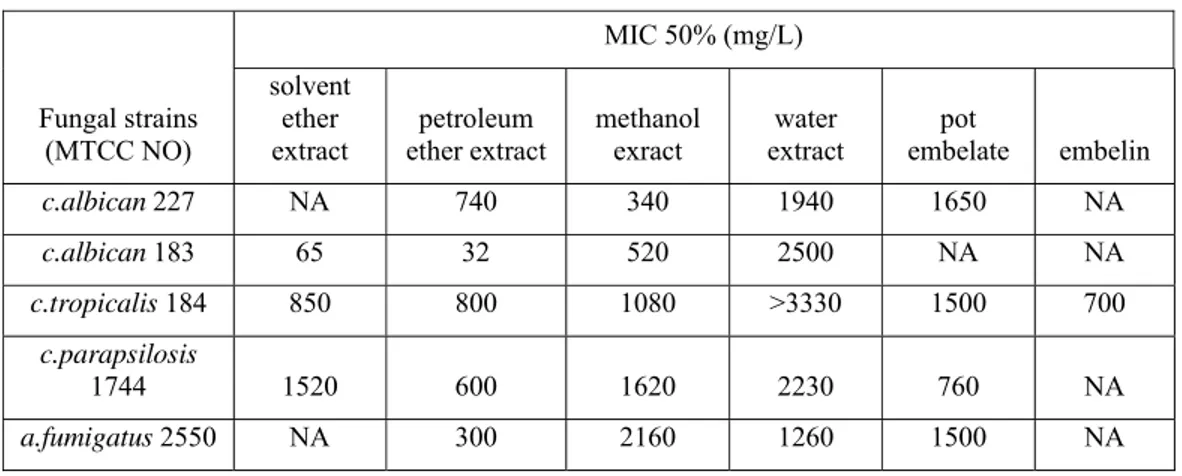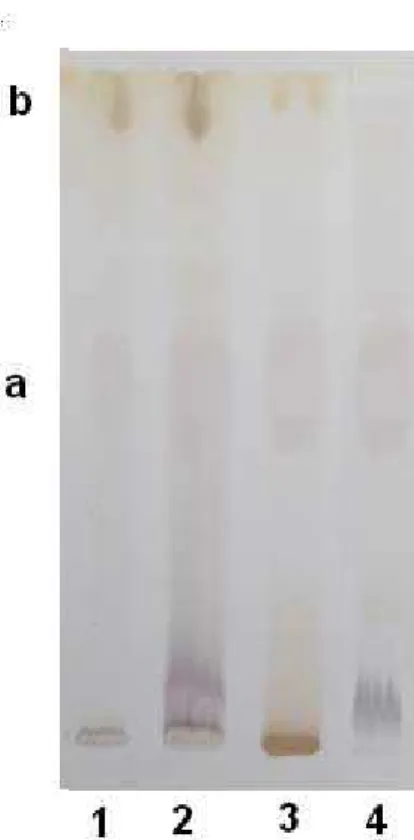In-Vitro Anti fungal Screening of Embelia
Ribes Plant Extract through EUCAST
Method
Sanjesh G Rathi 1*, Vaidhun H Bhaskar 1, Paras G Patel 1
1. M.P Patel College of Pharmacy, Department of Pharmaceutics, Jeevanshilp campus, kapadwanj, Dist-Kheda 387620, Gujarat, INDIA
ABSTRACT
Aim of the present study was to investigate the antifungal activity of the Embelia ribes plant extracts using standard in vitro antifungal susceptibility test method like EUCAST (European Committee on Antimicrobial Susceptibility Testing M27-A2 Protocol).Antifungal screening of Embelia ribes not studied in detail and not extended to the different spectrum of fungal which are causing human diseases. Thus different types of extracts were prepared using different solvents and TLC characterized. Assays were performed in 96 well plates and detection was carried out with colorimetric plate reader at 530nm.To obtain the MIC50 with the help of the graph pad prism software.The petroleum ether extract, solvent ether extract and methanol extract had low MIC50 values against the Candida species than the other species. Solvent ether extract and petroleum ether extract were highly effective against the c.albicans (MTCC NO 183) with the 65 mg/L and 32mg/L MIC50 values. The methanol extract were more active against c.albican (MTCC NO 183) species with 300-500 mg/L MIC50 value. The solvent ether extract, petroleum ether extract, methanol extract, potassium embelate and Embelin have reported the MIC50 values in range of 800-1600 mg/L against c.tropicalis (MTCC NO 184) and c.parapsilosis
(MTCC NO 1744). The petroleum ether extract and potassium embelate was found to have MIC50 between range 300-700 mg/L against c.parapsilosis (MTCC NO 1744) and a.fumigatus (MTCC NO 2550) .Other extracts required higher concentrations against c.parapsilosis and a.fumigatus. Water extract was found to have MIC50 values greater than 2000 mg/L against all fungus. Most of the results for the Embelin could not obtain by EUCAST method due to having higher fluctuation in results.
KEY WORDS:Embelin, Embelia ribes, EUCAST method, TLC
INTRODUCTION
Fungus is a eukaryotic organism that digests its food externally and absorbs the nutrient molecules into its cells. Fungal infections remain a significant cause of disease. Cryptococcus neoformans is the cause of the most common life-threatening meningitis in HIV-positive patients. Candida is one of the non-albicans strains currently emerging in fungal infections[1, 2]. To overcome these alarming problem researchers are increasingly turning their attention to folk medicine, looking for new leads to develop better drugs against microbial infections. Traditional medicines play important role in health services around the globe. About three quarter of the world’s population relies on plants and plant extracts for healthcare. Therefore, the discovery of novel active compounds against new targets is a matter of urgency[3, 4]. Thus the objective of this study was to investigate the antifungal activity of the Embelia ribes plant extracts using standard in vitro antifungal susceptibility test methods like EUCAST (European Committee on Antimicrobial Susceptibility Testing M27-A2 Protocol).
MATERIALS AND METHODS
Chemicals: Methanol (Finar reagents, lot no.17122334), petroleum ether, chloroform, n-propyl alcohol (Sd Fine chem. limited, lot no.G06A/0906/2305/31), n-butyl alcohol(Sd Fine chem. limited, lot no.K06A/0506/0811/13),ammonia (Finar reagents, lot no.18766789), ethanol, RPMI-1640 medium supplemented with glutamine and phenol red without bicarbonate ,(Himedia, lot no. 0000026654), 3-(N-morpholino) propanesulfonic acid (MOPS) (Himedia lot no. 0000028915), sodium hydroxide, glucose (Himedia lot no. 06-0960), resazurin (Himedia lot no. 0000002880), Czapek yeast extract agar, yeast malt agar (Himedia lot no. XL287), potato dextrose agar (Himedia lot no. 0000027587), amphotericin B, dimethyl sulphoxide (DMSO) Himedia lot no. 0000027905), water for injection.
Glass wares / plastic wares: 96- well plates, micropipettes, reagent bottles, test tubes, flasks, Petri dishes.
Micro organisms:
c.albican (MTCC no 227), c.albican (MTCC no 183), c.tropicalis (MTCC no 184), c.parapsilosis (MTCC no 1744), a.fumigatus (MTCC no 2550) obtained from microbial type culture collection (MTCC), sector 39-a, chandigarh-160036.
Plant material: Embelia ribes powder was obtained from m/s LVG, Ahmedabad and it was authenticated by Dr. Ritesh vaidya, department of biosciences, Ganpat University, Kherva
Preparation of the different extracts of Embelia ribes
20 gms of powdered plant material was taken in flask with 40 ml of the solvent. (Petroleum ether, solvent ether, methanol and water) the flask was allowed to saturation of drug powder for over night. Then after 24 hrs the solvent was filtrated by percolation method using whatmann filter paper. All extractive material was collected using fresh solvent until colour of the solvent become colour less. Collected extracts were evaporated to dryness in desiccators. The % yield of every extract was calculated [5, 6].
Extractive value and description of different extract of Embelia ribes
In present study to investigate the antifungal activity of the Embelia ribes; four different extract of the Embelia ribes were prepared using different solvents. The extractive values of the different extracts were calculated and reported in Table 1 with their description. According to the extractive values of the different extracts of the
Embelia ribes the highest compounds were solublized and extracted with petroleum ether. Petroleum ether extract was found to be brick red colored semisolid with 9.7 % extractive value. Water was reported lowest extractive value. The appearance of the water extract was dusty brown colored crust. The 9% and 6.3% extractive values were recorded for methanol and solvent ether extract. Methanol extract was in form of crystalline shiny powder of light brown color. Reddish orange colored semisolid extract was obtained by extraction with solvent ether. The solvent ether extract found to be more viscous than petroleum ether extract [5, 6].
TLC plate of the different extract of Embelia ribes
To examine the different extract of Embelia ribes; the TLC was spotted with four different spots for the petroleum ether extract, solvent ether extract, methanol extract and isolated Embelin. Then the TLC was developed in n-propanol: n-butanol: 4N ammonia (7:1:2) solvent system. The developed TLC chromatogram was shown in figure.1 .After the development of the TLC plate, it was found that the extracts were separated in 2 different zones. The chromatogram shows that the petroleum ether extract, solvent ether extract and methanol extract found to have the thick two fractions a and b. By comparing these three bands with the band of the isolated Embelin, they have same fraction that appeared in the isolated Embelin. The fraction b was reached the end of the solvent front in all the extracts but was absent in the isolate Embelin.
Preparation of broth medium For the EUCAST method:
Add 18 gm of glucose to the Roswell Park Memorial Institute broth RPMI-1640 medium with glutamine and phenol red (10.4 g), 3-(N-morpholino) propanesulfonic acid (MOPS) (34.53 g) in 400 ml distilled water to achieve 2%w/v glucose concentration . Adjust the pH to 7.0 at 25 °C with sodium hydroxide (1 mol/L). Make up the volume up to 0.5 L with water. Filter, sterilize and store at 4°C until required. [7].
Preparation of inocula:
Preparation of samples
Stock solutions of the plant extracts and the positive control drug (amphotericine B) were prepared in dimethyl sulphoxide (DMSO) at the concentrations of 100 mg/ml and 1.6 mg/ml, respectively and further diluted (1:30) in broth[7, 8].
Preparation of plates
Micro dilution susceptibility test was performed in flat-bottom 96-well clear plates containing broth medium (50μl) in each well. The Sample solutions were diluted with the broth and then serially diluted two-fold in the plates starting with the final concentration of 3330 mg/L for plant extracts and 5.3 mg/L for standard drug. The working inoculum suspension (50μl) was added to give a final inoculum concentration of 0.5–2.5 x 105 and 0.5–2.5 x 103 CFU/ml for EUCAST assays, respectively. The Sterility and growth controls were also included in the presence of organic solvents employed in sample preparation. The plates were incubated at 37°C for 24 hours and 48 hours for the NCCLS assays, respectively [7, 8, 9].
RESULT AND DISCUSSION
Determination of MIC50 valuesof the different Extracts
Plates were subjected at the plate reader after 24hrs, 48hrs and 72hrs at 530nm and the results of MIC50 were obtained with the help of the graph pad prism software. As shown in figure 2, the percentage growth was increased with the decrease in the concentration of the plant extracts, except for the water extract. The line for the water extract is roughly linear at all concentrations. Thus MIC50 can be obtained easily and the values of the MIC50 reported in Table 2 by EUCAST method revealed that The petroleum ether extract, solvent ether extract and methanol extract had low MIC50 values against the Candida species than the other species. Solvent ether extract and petroleum ether extract were highly effective against the c.albicans (MTCC NO 183) with the 65 mg/L and 32mg/L MIC50 values. The methanol extract were more active against c.albican (MTCC NO 183) species with 300-500 mg/L MIC50 value. The solvent ether extract, petroleum ether extract, methanol extract, potassium embelate and Embelin have reported the MIC50 values in range of 800-1600 mg/L against c.tropicalis
(MTCC NO 184) and c.parapsilosis (MTCC NO 1744). The petroleum ether extract and potassium embelate was found to have MIC50 between range 300-700 mg/L against c.parapsilosis (MTCC NO 1744) and
a.fumigatus (MTCC NO 2550) .Other extracts required higher concentrations against c.parapsilosis and
a.fumigatus. Water extract was found to have MIC50 values greater than 2000 mg/L against all fungus. Most of the results for the Embelin could not obtain by EUCAST method due to having higher fluctuation in results.
Table 1: Percentage yield of different extracts of Embelia ribes
Extracts of Embelia ribes Percentage yield
petroleum ether extract 9.7
solvent ether extract 6.3
Methanol extract 9
Table2: Activity of different plant extracts of Embelia ribes against fungal strains using EUCAST method
Fungal strains (MTCC NO)
MIC 50% (mg/L) solvent
ether extract
petroleum ether extract
methanol exract
water extract
pot
embelate embelin
c.albican 227 NA 740 340 1940 1650 NA
c.albican 183 65 32 520 2500 NA NA
c.tropicalis 184 850 800 1080 >3330 1500 700
c.parapsilosis
1744 1520 600 1620 2230 760 NA
Figure 1: Image of TLC plate where 1- Petroleum ether extract 2- Solvent ether extract 3- Methanol extract 4- Isolated crude Embelin
Figure2: Graphs of the extracts concentration against percentage growth of Candida tropicalis by EUCAST method.
CONCLUSION
The water extract showed no activity against any fungal stains, which could have been due to the poor solubility of the components of the Embelia ribes in water. Embelin, which is traditionally used as anthelmintic, showed the good inhibitory activity against c.tropicalis Potassium embelate which was reported good analgesic agent; showed moderate activity against all fungal species (required higher concentration). Solvent ether extract, petroleum ether extract and methanol extract showed good activity
EUCAST c. tropicalis 184
-100 -50 0 50 100 150
3330 1665 832.5 416.3 208.1 104.1 52.03 26.02 13.01 6.504
con(mg/L)
%g
ro
w
th
solvent ether
petrolium ether
methanolic
water
against Candida tropicalis; resembling the activity of Embelin and gave evidence of the presence of Embelin in these extracts.
ACKNOWLEDGEMENT
We are thankful to Dr.Ritesh Vaidya, Dept. of Biosciences, Ganpat University Kherva, for authentification of the plant.
REFERENCES
[1] Powderly WG, Mayer KH, Perfect JR., AIDS Res. Hum. Retroviruses, 1999; 15: 1405-1412. [2] Tahir M, Sharma SK, Sinha S, Das CJ., Jrnl of post grad. med. 2007; 53 (4): 250-252. [3] Chakrabarti A, Shivaprakash MR., Jrnl of post grad. Med., 2005; 51: 16-20
[4] Srinivasan D, Sangeetha N, Suresh T, Perumalsamy PL, J. Ethnopharmacol, 2001; 74: 217-220. [5] Hao K, Ali M, Siddiqui AW, Pharmazie 2005;60(1): 69-71
[6] Chitra M, Sukumar E, Suja V, Shyamala Devi C.S., science, 2003; 74 (4) :401-403 [7] LinaresMJ , Solı´s F, CasalIn M, J. clinical microbiology, 2005, 43(5): 2520–2522 [8] Hostettman K, Marston A., Pure &App. Chem., 1994, 66(10): 2231-2234

